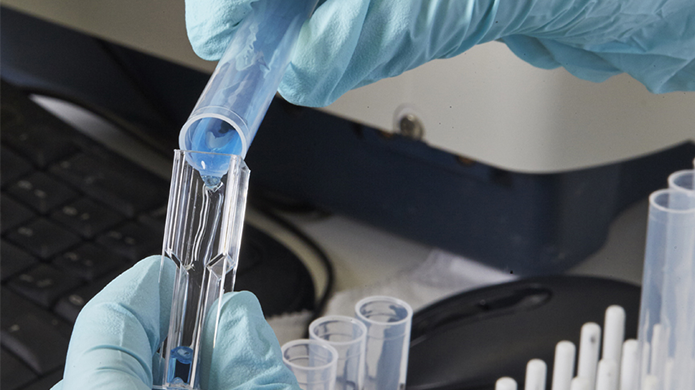A throwback to the recent research by Olmix Group and INRAe, which showed that a green algae extract stimulates the production of immune mediators through intestinal epithelial cells. These results indicate that this kind of preparation could be used in livestock feed to improve their resistance to infections and therefore reduce the use of antibiotics.
Antibiotics have long been used in farming stock as growth promoters to protect animals against pathogenic agents. However, European directives have been adopted with a view to implementing sustainable farming without the addition of antibiotics. Effective alternative prophylactic strategies are therefore important to improve animals’ resistance to infections.
A growing industry
The marine algae business is attracting growing interest due to their nutritional quality, as well as the wealth of bioactive molecules contained in these organisms, mostly eukaryotes or prokaryotes in the case of cyanobacteria. Algae can be either unicellular (microalgae) or multicelular (macroalgae). The latter are divided into three evolutionary lines: green, red and brown algae. Their evolutionary differences provide them with great diversity, both phenotypic – their size varies from a few millimetres to 70 metres – and metabolic.
Macroalgae contain a wealth of diverse and specific molecules. In terms of their composition, most are made up of so-called “parietal” carbohydrates (essentially polysaccharides), proteins, infinitely diverse minerals lipids, vitamins and pigments. The nature of seaweed sulfated polysaccharides that make up the cell walls varies with the family of algae. There are mainly alginates in brown algae, carrageenan and agar in red algae, and ulvanes in green algae. They represent 4-6% of dry weight.

The particularity of seaweed sulfated polysaccharides lies in their complexity: they can be ramified, unlike linear polysaccharides such as cellulose. They are made up of varied saccharide units (uronic acids, xylose and fucose), unlike homopolysaccharides such as starch, which is composed of glucose only. They may also contain rare carbohydrates, such as rhamnose. Finally, some of their carbohydrates can be sulfated, a characteristic essential to their biological activity.
All of these parameters indicate a structural similarity with animal polysaccharides, notably heparin, which explains their unique biological activities for photosynthetic organisms. In addition, seaweed sulfated polysaccharides have highly variable functions and structures depending on the nature of their carbohydrates, the repetition ofoligosaccharide motifs in the polysaccharide, the nature of their oligosaccharide links, their level of ramification, their molecular weight and their degree of sulfation. In this way, many MSP®s with distinct biological activities can be found in macroalgae.
An increasing number of publications highlight the unique biological properties of these polysaccharides (anti-infectious, antioxidant, antithrombotic and immunomodulatory), which have applications in the fields of animal, plant and human health.
Scientific research between Olmix Group and INRAe
Under a recent research partnership between Olmix Group and the INRA Val de Loire centre, a low molecular weight seaweed sulfated polysaccharides was identified and isolated by Olmix from Ulva armoricana green algae, harvested in Brittany. This specific extract, named “MSP®IMMUNITY“ was tested in vitro to evaluate, the simulation of immune mediators in the intestine of the host animal using IPEC1, a porcine intestinal epithelial cell line. Used as a feed additive, the MSP® could offer a new prophylactic strategy to improve livestock health and reduce the use of antibiotics, to which pathogenic agents are increasingly resistant.
MSP® stimulates the expression of mediators of the immune resonse through intestinal cell
The biological activity of this macroalgal MSP® was studied by testing its capacity to stimulate the immune response of the host, using an in vitro system of polarised porcine epithelial cells (IPEC1).
After these cells had been in contact with 1, 0.1 and 0.01 mg/ml of MSP® for four hours, the relative quantification of the expression of the messenger RNA (mRNA) of a panel of immune mediators was analysed by RT-qPCR. The treatment of the IPEC1 polarized cells with the MSP® resulted in the regulation of the mRNAs in a wide range of cytokines such as interleukin IL-1α, IL-1β, IL-6, IL-8, and TNFα. These results suggest that MSP® could activate the intestinal epithelial cells so that they produce cytokines of the cell-mediated immune response, which will initiate and amplify the protective immune responses of the host and thus regulate the mucosal immunity against the intestinal pathogenic agents.
Further, the expresión of chemokine CCL20 (MIP3a) – whose interaction with its receptor, CCR6, is involved in the recruitment of dendritic cells, B and T cells, and in the regulation of intestinal immune homeostasis or in inflammatory conditions – is also highly regulated by the MSP®. This also leads to an accumulation of TGFβ mRNA, suggesting that this extract could participate effectively in the humoral immunity response of immonoglobulines A and the antiinflammatory process in the intestine.
The MSP® also stimulates the expression of PPARy mRNA, a transcription factor involved in both inhibiting the expression of inflammatory cytokines and differentiating the immune system cells towards anti-inflammatory phenotypes. These in vitro results are comparable to those of previous studies that have shown that the sulfated polysaccharides derived from algae have an immunomodulating action capable of stimulating the immune response and controlling the inflammatory proces.

An alternative method to reduce the use of antibiotics
The results of the INRAe study show that the extract of sulfated polysaccharide-rich green algae has the ability to simulate in vitro the expression of the cytokines involved in the activation, recruitment and migration of lymphocytes and dendritic cells to modulate the immune response. This extract could therefore be used in livestock feed to stimulate the immune response of the host animals.
These in vitro results have been have paved the way for further studies to better elucidate the mechanism of action and studies to optimize the recommandation in vivo directly on the target animal. It is essential to ensure that the oral administration of these algal extracts will produce beneficial effects, without disrupting the normal functioning of the digestive tube, ensuring normal livestock growth and well-being. This sort of alternative method could reduce the situations requiring therapeutic approaches and therefore potentially the use of antibiotics.




